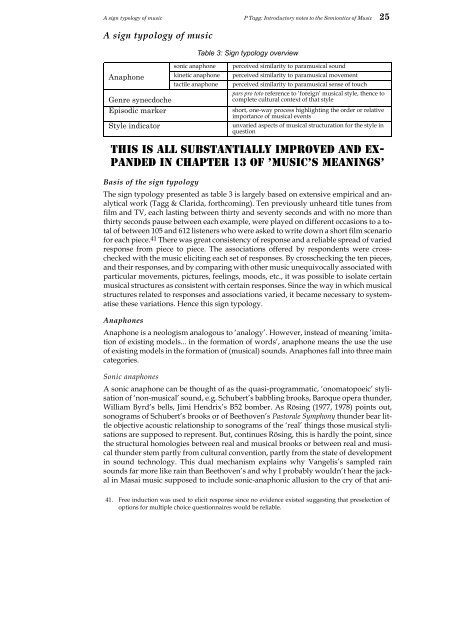Introductory notes to the Semiotics of Music - Philip Tagg's home page
Introductory notes to the Semiotics of Music - Philip Tagg's home page
Introductory notes to the Semiotics of Music - Philip Tagg's home page
Create successful ePaper yourself
Turn your PDF publications into a flip-book with our unique Google optimized e-Paper software.
A sign typology <strong>of</strong> music P Tagg: <strong>Introduc<strong>to</strong>ry</strong> <strong>notes</strong> <strong>to</strong> <strong>the</strong> Semiontics <strong>of</strong> <strong>Music</strong> 25<br />
A sign typology <strong>of</strong> music<br />
Anaphone<br />
Genre synecdoche<br />
Episodic marker<br />
Style indica<strong>to</strong>r<br />
Table 3: Sign typology overview<br />
sonic anaphone perceived similarity <strong>to</strong> paramusical sound<br />
kinetic anaphone perceived similarity <strong>to</strong> paramusical movement<br />
tactile anaphone perceived similarity <strong>to</strong> paramusical sense <strong>of</strong> <strong>to</strong>uch<br />
pars pro <strong>to</strong><strong>to</strong> reference <strong>to</strong> ‘foreign’ musical style, <strong>the</strong>nce <strong>to</strong><br />
complete cultural context <strong>of</strong> that style<br />
short, one-way process highlighting <strong>the</strong> order or relative<br />
importance <strong>of</strong> musical events<br />
unvaried aspects <strong>of</strong> musical structuration for <strong>the</strong> style in<br />
question<br />
THIS IS ALL SUBSTANTIALLY IMPROVED AND EX-<br />
PANDED IN CHAPTER 13 OF ’<strong>Music</strong>’s Meanings’<br />
Basis <strong>of</strong> <strong>the</strong> sign typology<br />
The sign typology presented as table 3 is largely based on extensive empirical and analytical<br />
work (Tagg & Clarida, forthcoming). Ten previously unheard title tunes from<br />
film and TV, each lasting between thirty and seventy seconds and with no more than<br />
thirty seconds pause between each example, were played on different occasions <strong>to</strong> a <strong>to</strong>tal<br />
<strong>of</strong> between 105 and 612 listeners who were asked <strong>to</strong> write down a short film scenario<br />
for each piece. 41 There was great consistency <strong>of</strong> response and a reliable spread <strong>of</strong> varied<br />
response from piece <strong>to</strong> piece. The associations <strong>of</strong>fered by respondents were crosschecked<br />
with <strong>the</strong> music eliciting each set <strong>of</strong> responses. By crosschecking <strong>the</strong> ten pieces,<br />
and <strong>the</strong>ir responses, and by comparing with o<strong>the</strong>r music unequivocally associated with<br />
particular movements, pictures, feelings, moods, etc., it was possible <strong>to</strong> isolate certain<br />
musical structures as consistent with certain responses. Since <strong>the</strong> way in which musical<br />
structures related <strong>to</strong> responses and associations varied, it became necessary <strong>to</strong> systematise<br />
<strong>the</strong>se variations. Hence this sign typology.<br />
Anaphones<br />
Anaphone is a neologism analogous <strong>to</strong> ‘analogy’. However, instead <strong>of</strong> meaning ‘imitation<br />
<strong>of</strong> existing models... in <strong>the</strong> formation <strong>of</strong> words’, anaphone means <strong>the</strong> use <strong>the</strong> use<br />
<strong>of</strong> existing models in <strong>the</strong> formation <strong>of</strong> (musical) sounds. Anaphones fall in<strong>to</strong> three main<br />
categories.<br />
Sonic anaphones<br />
A sonic anaphone can be thought <strong>of</strong> as <strong>the</strong> quasi-programmatic, ‘onoma<strong>to</strong>poeic’ stylisation<br />
<strong>of</strong> ‘non-musical’ sound, e.g. Schubert’s babbling brooks, Baroque opera thunder,<br />
William Byrd’s bells, Jimi Hendrix’s B52 bomber. As Rösing (1977, 1978) points out,<br />
sonograms <strong>of</strong> Schubert’s brooks or <strong>of</strong> Beethoven’s Pas<strong>to</strong>rale Symphony thunder bear little<br />
objective acoustic relationship <strong>to</strong> sonograms <strong>of</strong> <strong>the</strong> ‘real’ things those musical stylisations<br />
are supposed <strong>to</strong> represent. But, continues Rösing, this is hardly <strong>the</strong> point, since<br />
<strong>the</strong> structural homologies between real and musical brooks or between real and musical<br />
thunder stem partly from cultural convention, partly from <strong>the</strong> state <strong>of</strong> development<br />
in sound technology. This dual mechanism explains why Vangelis’s sampled rain<br />
sounds far more like rain than Beethoven’s and why I probably wouldn’t hear <strong>the</strong> jackal<br />
in Masai music supposed <strong>to</strong> include sonic-anaphonic allusion <strong>to</strong> <strong>the</strong> cry <strong>of</strong> that ani-<br />
41. Free induction was used <strong>to</strong> elicit response since no evidence existed suggesting that preselection <strong>of</strong><br />
options for multiple choice questionnaires would be reliable.














